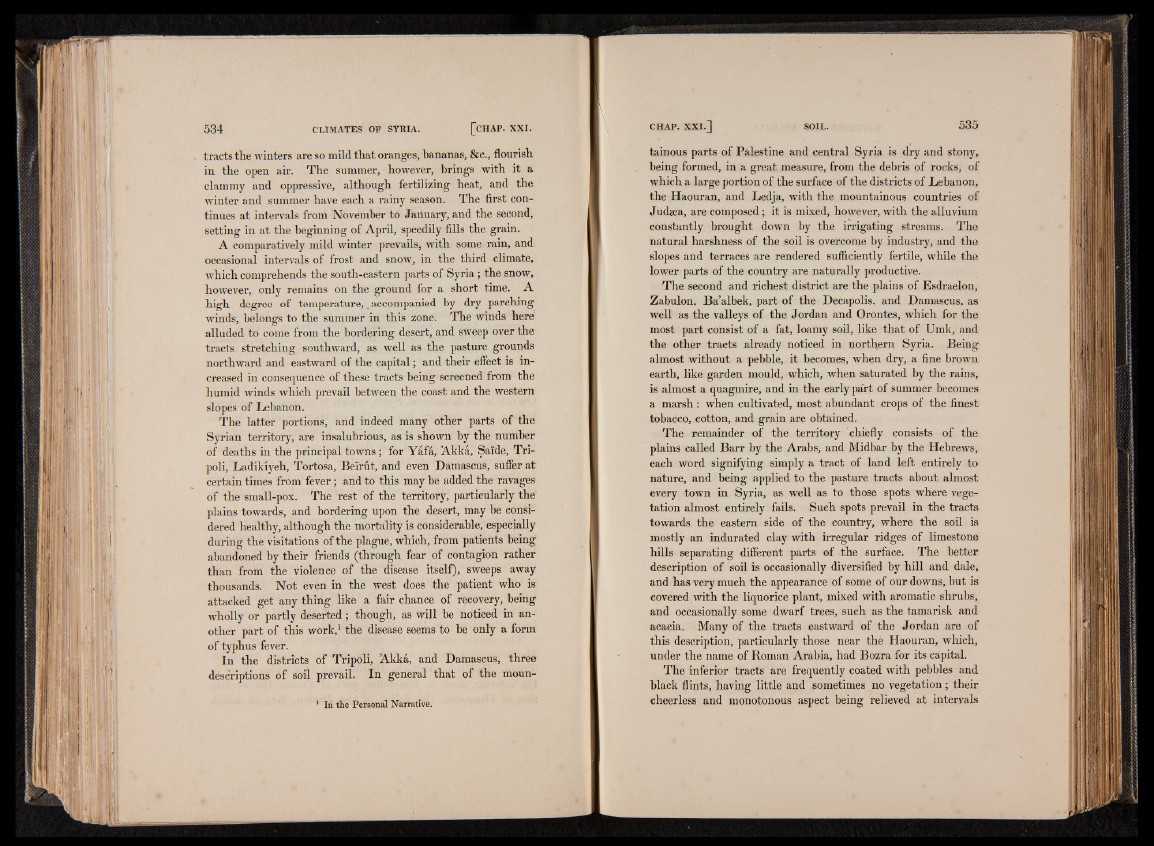
tracts the winters are so mild that oranges, bananas, &c., flourish
in the open air. The summer, however, brings with it a
clammy and oppressive, although fertilizing heat, and the
winter and summer have each a rainy season. The first continues
at intervals from November to January, and the second,
setting in at the beginning of April, speedily fills the grain.
A comparatively mild winter prevails, with some rain, and
occasional intervals of frost and snow, in the third climate,
which comprehends the south-eastern parts of Syria; the snow,
however, only remains on the ground for a short time. A
high degree of temperature,, accompanied by dry parching
winds, belongs to the summer in this zone. The winds here
alluded to come from the bordering desert, and sweep over the
tracts stretching southward, as well as the pasture grounds
northward and eastward of the capital; and their effect is increased
in consequence of these tracts being screened from the
humid winds which prevail between the coast and the western
slopes of Lebanon.
The latter portions, and indeed many other parts of the
Syrian territory, are insalubrious, as is shown by the number
of deaths in the principal towns; for Yafa, Akka, Sai'de, Tripoli,
Ladikiyeh, Tortosa, Beirut, and even Damascus, suffer at
certain times from fever; and to this may be added the ravages
of the small-pox. The rest of the territory, particularly the
plains towards, and bordering upon the desert, may be considered
healthy, although the mortality is considerable, especially
during the visitations of the plague, which, from patients being
abandoned by their friends (through fear of contagion rather
than from the violence of the disease itself), sweeps away
thousands. Not even in the west does the patient who is
attacked get any thing like a fair chance of recovery, being
wholly or partly deserted; though, as will be noticed in another
part of this work,1 the disease seems to be only a form
of typhus fever.
In the districts of Tripoli, Akka, and Damascus, three
descriptions of soil prevail. In general that of the moun1
In the Personal Narrative.
tainous parts of Palestine and central Syria is dry and stony,
being formed, in a great measure, from the debris of rocks, of
which a large portion of the surface of the districts of Lebanon,
the Haouran, and Ledja, with the mountainous countries of
Judsea, are composed; it is mixed, however, with the alluvium
constantly brought down by the irrigating streams. The
natural harshness of the soil is overcome by industry, and the
slopes and terraces are rendered sufficiently fertile, while the
lower parts of the country are naturally productive.
The second and richest district are the plains of Esdraelon,
Zabulon, Ba’albek, part of the Decapolis, and Damascus, as
well as the valleys of the Jordan and Orontes, which for the
most part consist of a fat, loamy soil, like that of Umk, and
the other tracts already noticed in northern Syria. Being
almost without a pebble, it becomes, when dry, a fine brown
earth, like garden mould, which, when saturated by the rains,
is almost a quagmire, and in the early part of summer becomes
a marsh: when cultivated, most abundant crops of the finest
tobacco, cotton, and grain are obtained.
The remainder of the territory chiefly consists of the
plains called Barr by the Arabs, and Midbar by the Hebrews,
each word signifying simply a tract of land left entirely to
nature, and being applied to the pasture tracts about almost
every town in Syria, as well as to those spots where vegetation
almost entirely fails. Such spots prevail in the tracts
towards the eastern side of the country, where the soil is
mostly an indurated clay with irregular ridges of limestone
hills separating different parts of the surface. The better
description of soil is occasionally diversified by hill and dale,
and has very much the appearance of some of our downs, but is
covered with the liquorice plant, mixed with aromatic shrubs,
and occasionally some dwarf trees, such as the tamarisk and
acacia. Many of the tracts eastward of the Jordan are of
this description, particularly those near the Haouran, which,
under the name of Roman Arabia, had Bozra for its capital.
The inferior tracts are frequently coated with pebbles and
black flints, having little and sometimes no vegetation; their
cheerless and monotonous aspect being relieved at intervals